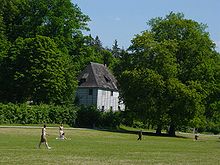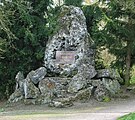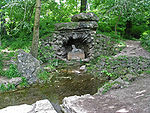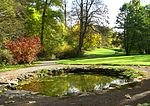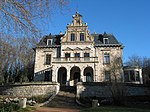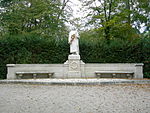
Weimar is a city in the state of Thuringia, Germany. It is located in Central Germany between Erfurt in the west and Jena in the east, approximately 80 kilometres southwest of Leipzig, 170 kilometres north of Nuremberg and 170 kilometres west of Dresden. Together with the neighbouring cities of Erfurt and Jena, it forms the central metropolitan area of Thuringia, with approximately 500,000 inhabitants. The city itself has a population of 65,000. Weimar is well known because of its large cultural heritage and its importance in German history.
This article contains information about the literary events and publications of 1774.

Schloss Altenstein is a schloss, or palace, upon a rocky hill on the south-western slope of the Thuringian Forest, not far from Eisenach, Thuringia, Germany. It was the summer residence of the Dukes of Saxe-Meiningen, and is surrounded by 160 hectares of English landscape garden, which contain, among other objects of interest, a cavern 300 metres long, through which flows a large and rapid stream.
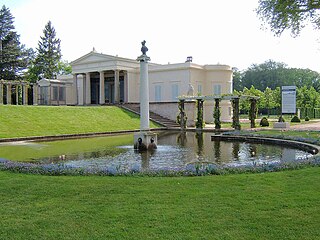
Charlottenhof Palace or Charlottenhof Manor is a former royal palace located southwest of Sanssouci Palace in Sanssouci Park at Potsdam, Germany. It is best known as the summer residence of Crown Prince Frederick William. Today it is maintained by the Prussian Palaces and Gardens Foundation Berlin-Brandenburg.

Weimar Classicism was a German literary and cultural movement, whose practitioners established a new humanism from the synthesis of ideas from Romanticism, Classicism, and the Age of Enlightenment. It was named after the city of Weimar, Germany, because the leading authors of Weimar Classicism lived there.

Johanna Christiana Sophie Vulpius von Goethe was the longtime lover and later wife of Johann Wolfgang von Goethe.

Georg Melchior Kraus was a German painter. He was a co-founder of the Weimar Princely Free Drawing School, together with Friedrich Justin Bertuch, in 1776.

The Weimar Princely Free Drawing School was an art and literature educational establishment. It was set up in 1776 in Weimar by the scholar and ducal private-secretary Friedrich Justin Bertuch (1747–1822) and the painter Georg Melchior Kraus (1737–1806), as part of Weimar Classicism. It was financed by the young Charles Augustus, Grand Duke of Saxe-Weimar-Eisenach and heavily promoted by Goethe, who also taught there. Among its pupils were Charles Augustus's future mistress Karoline Jagemann. It lasted until 1930.

Tiefurt House is a small stately home on the Ilm river in the Tiefurt quarter of Weimar, about 4 km east of the city centre. It was the summer residence of duchess Anna Amalia of Brunswick-Wolfenbüttel. Because of its importance as a centre of culture during the Weimar Classicism movement of the late 18th and early 19th centuries, the Tiefurt House was inscribed on the UNESCO World Heritage List in 1998 as part of the Classical Weimar site.
The Konferenz Nationaler Kultureinrichtungen (KNK) or Conference of National Cultural Institutions is a union of more than twenty cultural organizations in the former East Germany. It was established in 2002 in Halle.

Bergpark Wilhelmshöhe is a landscape park in Kassel, Germany. The area of the park is 2.4 square kilometres, making it the largest European hillside park, and second largest park on a hill slope in the world. Construction of the Bergpark, or "mountain park", began in 1689 at the behest of the Landgraves of Hesse-Kassel and took about 150 years. The park is open to the public today. Since 2013, it has been a UNESCO World Heritage Site because of its monumental Baroque architecture and its unique fountains and water features.

The Goethe-Nationalmuseum is a museum devoted to the German author Johann Wolfgang von Goethe, in the town of Weimar in Germany. Originally comprising the Goethe House, where Goethe lived intermittently for 50 years from 1782 to 1832, the museum was founded on 8 August 1885 as a result of the will of Goethe's last living heir, his grandson Walther von Goethe, who left the Goethe House to the state.

Classical Weimar is a UNESCO World Heritage Site consisting of 11 sites located in and around the city of Weimar, Germany. The site was inscribed on 2 December 1998. The properties all bear testimony to the influence of Weimar as a cultural centre of the Enlightenment during the eighteenth and early nineteenth centuries. A number of notable writers and philosophers lived in Weimar between 1772 and 1805, including Johann Wolfgang von Goethe, Johann Gottfried Herder, Friedrich Schiller, and Christoph Martin Wieland. These figures ushered in and participated in the Weimar Classicism movement, and the architecture of the sites across city reflects the rapid cultural development of the Classical Weimar era.

The Klassik Stiftung Weimar is one of the largest and most significant cultural institutions in Germany. It owns more than 20 museums, palaces, historic houses and parks, as well as literary and art collections, a number of which are World Heritage Sites.

Babelsberg Park is a 114 hectare park in the northeast of the city of Potsdam, bordering on the Tiefen See lake on the River Havel. The park was first designed by the landscape artist Peter Joseph Lenné and, after him, by Prince Hermann von Pückler-Muskau and Karl Friedrich Schinkel, by order of the then-prince William I and his wife, Augusta. Located on a hill sloping down to the lake, the park and castle are part of the Palaces and Parks of Potsdam and Berlin, which were inscribed on the UNESCO World Heritage List because of their unique architecture and testimony to the development of landscape design.

Babelsberg Palace lies in the eponymous park and quarter of Potsdam, the capital of the German state of Brandenburg, near Berlin. For over 50 years it was the summer residence of Prince William, later German Emperor William I and King of Prussia and his wife, Augusta of the House of Saxe-Weimar-Eisenach, German Empress and Queen of Prussia. Along with the surrounding park and other parks in the area, the Babelsberg Palace was inscribed on the UNESCO World Heritage list in 1990 for its architectural cohesion and its testimony to the power of the Prussian monarchy.

Schloss Weimar is a Schloss (palace) in Weimar, Thuringia, Germany. It is now called Stadtschloss to distinguish it from other palaces in and around Weimar. It was the residence of the dukes of Saxe-Weimar and Eisenach, and has also been called Residenzschloss. Names in English include Palace at Weimar, Grand Ducal Palace, City Palace and City Castle. The building is located at the north end of the town's park along the Ilm river, Park an der Ilm. It forms part of the World Heritage Site "Classical Weimar", along with other sites associated with Weimar's importance as a cultural hub during the late 18th and 19th centuries.

The Weimar courtyard of the muses is a term, that had emerged during the 19th century. It refers to an elite fellowship of people in Classical Weimar (1772-1805), that was made up of nobles and commoners, courtiers, civil servants, writers, artists and scientists, who congregated around the central character, Duchess Anna Amalia of Saxe-Weimar-Eisenach, pioneer of Weimar Classicism and patroness of the arts. Duchess Anna Amalia was the mother and from 1758 until 1775 regent for the infant Grand Duke Karl August von Sachsen-Weimar-Eisenach. Among the poets living in Weimar were the most famous German authors of their time, Johann Wolfgang von Goethe, Friedrich Schiller, Christoph Martin Wieland and Johann Gottfried Herder.

Johann Konrad Horny was a German painter, graphic artist, and copper engraver.
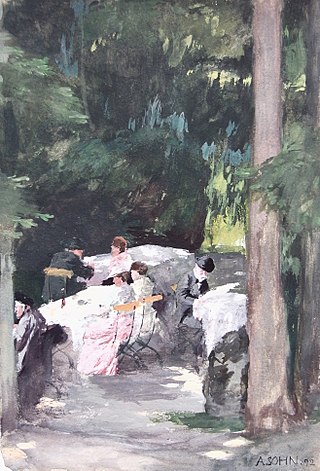
The Malkastenpark is a historic private park, now in the centre of Düsseldorf, North Rhine-Westphalia, Germany. The name refers to a group of artists, Malkasten, founded in 1848. The park is also known as the Jacobigarten, after the original owners who created a Baroque garden. It is now a public garden with both Baroque features and English landscape garden elements, and a listed historic monument.


